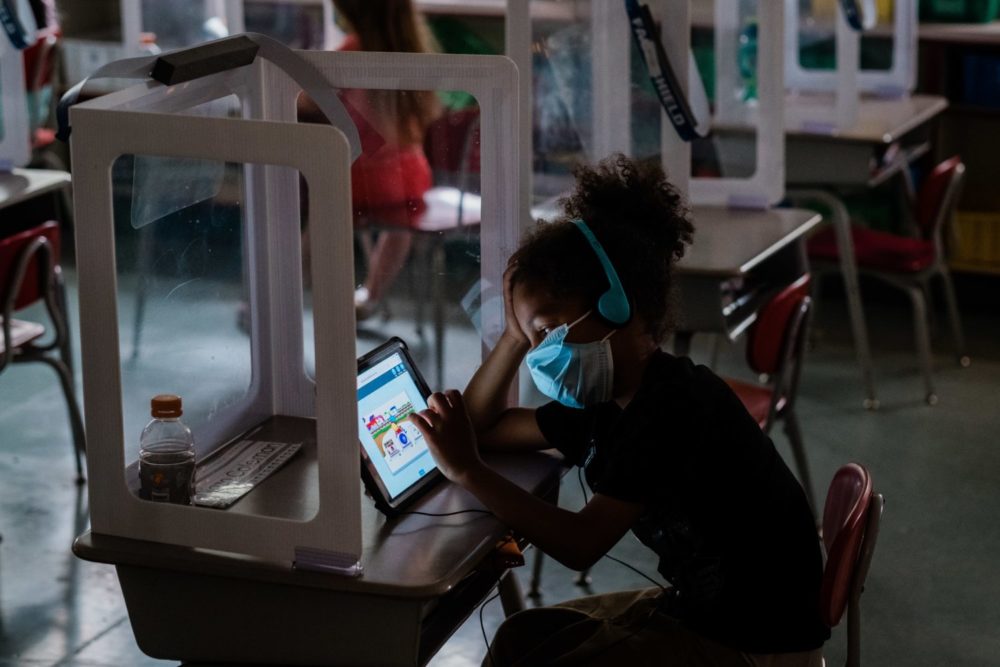
3 bold moves by local school districts are putting students at the center
Photo above courtesy of Remake Learning’s Tomorrow campaign.
Decade after decade, alarm clocks rang in the predawn silence in the bedrooms of Hampton Township’s sleep-deprived teenagers. No matter how late they’d gotten to bed the night before, by 7 a.m. on weekday mornings most were outside climbing aboard school buses.
Those bus-riding kids, at least, had a shot at grabbing an extra five minutes of sleep on the way to school. Many of the juniors and seniors with cars and new drivers’ licenses were motoring up and down the roller-coaster hills that lead to Hampton High School’s entrance—some on just four or five hours’ sleep.
No one thought this was ideal. There must be a better way to begin a full day of learning. But a century of high schoolers throughout America have started their mornings this early. It seemed like an unavoidable reality.
Until it didn’t.
Making the Leap
Just a few weeks ago, Hampton announced a big change: High school would now begin at 8:20 a.m., nearly an hour later than the old 7:30 start time.
The decision was based on two things: solid research into the science of teen sleep and lots of communication with the community. But even with that in place, actually making the change happen was still a bold choice.
Changing bus schedules for high schoolers impacts busing for all the other kids in the district. The shift also puts Hampton out of sync with neighboring districts, upending afterschool sports schedules. And coordination with the tech center where many high schoolers spend part of their day was suddenly complicated.
Most challenging of all? Hampton parents—many of whom attended Hampton themselves on the old schedule—had to accept all this.
“We knew this would be a major change,” says Hampton superintendent Dr. Michael Loughead. But after 18 months of pandemic disruption and challenge, he says, “this is a time for bold moves.”
That sentiment echoes the message of the “Remaking Tomorrow: What Comes Next?” report, published in June: We can’t go back to any “normal” that wasn’t truly serving all students. And districts can’t let the momentum of recent months fade without real progress.
Putting groundbreaking ideas into action can be a struggle for some districts, says Dr. Katie Martin, author of “Evolving Education: Shifting to a Learner-Centered Paradigm” and a consultant who works with schools around the country. More than 18 months of disruption has left them craving pre-pandemic normalcy, even if it wasn’t great.
But many others, she says, are starting “to really push the edges” by prioritizing social-emotional learning and focusing on meeting learners’ needs in new ways.
Building a Learner-Centered World
Among other big shifts happening locally: Butler Area School District is collaborating directly with local businesses, government agencies and community members to map out the future of learning in Butler.
Some of the questions this group is being asked: “What are the new outcomes that we really want for our kids? Are we really just anchored on standardized test scores, and older metrics, or are we starting to think differently about the data that we have and what we really want for our students?”
And in recent weeks, A+ Schools and other members of the Pittsburgh Learning Collaborative (PLC) have helped Pittsburgh Public Schools (PPS) design a last-minute but creative solution to the challenges caused by the nationwide bus driver shortage.
Faced with a major shortfall of drivers, PPS has expanded the “walk zones” around many schools and shifted some students from yellow school buses to Port Authority buses. So the PLC and PPS collaborated to build an untested solution to help kids with these unfamiliar routes to school: For the first six weeks of school, teams of “navigation ambassadors” are stationed at intersections around the city to help kids walk to school safely or board the correct bus.
Beyond keeping kids from getting lost, these adults can hopefully help kids feel more comfortable with their new routines. The project — funded by the school district and administered by A+ Schools — is a new level of collaboration between community organizations and K-12 schools.
Will it work perfectly? “Honestly, we’ve never done this before,” Fogarty says. The organizers are still hiring ambassadors even though school has begun. But they will make improvements as they go.
Hampton High School made the same type of considered but ultimately untested leap. Will they see the same results that other districts around the country with later start times have found—better academic outcomes and fewer sports injuries and student car accidents?
There are no guarantees. But they know that later a start time “has been shown to help reduce some of the mental health challenges—the anxiety and depression—that are sometimes caused by sleep deprivation,” Loughead says.
So while the move brought a host of logistical challenges and pushed Hampton to adjust to a big change, this year—the ideal year to think innovatively and passionately about what students need from their schools and communities—was the moment to try.
“This opportunity,” Loughead says, “couldn’t come at a better time.”
This article is part of a series for “Tomorrow” powered by Remake Learning. From May to October, “Tomorrow” will explore – through virtual events, grantmaking, and storytelling – what we can do today to make tomorrow a more promising place for all learners. Follow along or share your hopes for today’s young people using the hashtag #RemakeTomorrow and tagging @RemakeLearning. Learn more about Remake Learning here. And read more “Tomorrow” articles published on Kidsburgh.